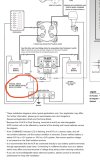Has anyone (
@BCI ) ever dealt with having a start battery tied into a double 6V house setup? That's what I currently have and it seems to complicate things when trying to figure out what's doing what. There's two start batteries, one port and one starboard. The port alternator charges the house bank but is still started by it's own start battery. My kicker is supposed to be charging my house bank but it doesn't seem to be working. I'm having electrical gremlins pop up and I'm thinking it has to do with the house bank not running at full capacity any longer. I've heard once the 6V go things will just stop working because they aren't getting the full voltage needed. Even though the batteries are fully charged. That or it's a bad ground. Sorry that's a lot to digest. I think there's a question in there somewhere
It would be helpful to see/understand the wiring more completely. Most kickers put out 6A approx when revving out... won't really charge much but should keep your chart plotter running. If I recall correctly you have a 15hp Merc Pro-Kicker which puts out 12A when revving. From that 12A assume you have 5A left after house loads (chart plotter, fridge, etc).
If you have a 100A 6V+6V string you'll take far in excess of 20 hours to charge with the kicker if everything is 100% good.
If your batteries are old / dying, they won't get to a full charge or give you a full capacity... so a few things to ask;
Battery Health;
How old are the batteries? Load test them?
To understand the existing engine charging system;
What does port engine charge?
What does STDB engine charge? Is there any combiner/BEP VSR system which takes the alternator output into
whatever battery needs it? (Usually starting strings are priority #1).
To understand the shore power charging system;
Does onboard charger have enough capacity for your house and starting strings? i.e. are you getting 100% charge on shore power before taking off for the morning?
Could be battery banks undersized for your usage, or battery banks on last legs and need replacement, or charger just not getting them charged up enough for you overnight, or loose wiring / terminals.
I wouldn't count on the kicker doing anything except keeping your kicker running and your GPS running etc... alternator output just too small on kickers to make a big difference.
I know you hate the noise, but you could run a Honda 1000W generator for one hour and if you have a 100A charger onboard that'll do a lot more than the kicker ever will for recharging...
I put a 150W solar panel on my roof of my boat and I see 10A-12A being fed to the battery bank on a sunny day... Wasn't too expensive and really helps. Another option for you on the list...
These days with labour rates being what they are, I tend to just replace the batteries when I think they're time is up... rather than spending on diagnostics which are probably just going to tell you to replace your batteries anyways...


